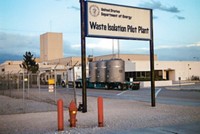Advertisement
Grab your lab coat. Let's get started
Welcome!
Welcome!
Create an account below to get 6 C&EN articles per month, receive newsletters and more - all free.
It seems this is your first time logging in online. Please enter the following information to continue.
As an ACS member you automatically get access to this site. All we need is few more details to create your reading experience.
Not you? Sign in with a different account.
Not you? Sign in with a different account.
ERROR 1
ERROR 1
ERROR 2
ERROR 2
ERROR 2
ERROR 2
ERROR 2
Password and Confirm password must match.
If you have an ACS member number, please enter it here so we can link this account to your membership. (optional)
ERROR 2
ACS values your privacy. By submitting your information, you are gaining access to C&EN and subscribing to our weekly newsletter. We use the information you provide to make your reading experience better, and we will never sell your data to third party members.
Letters to the editor
DNA data storage
William L. Hughes and George D. Dickinson’s work featured in C&EN (May 3, 2021, page 6) discusses how DNA origami and superresolution fluorescence microscopy can work as a method to offer a novel approach to data storage based on DNA bar coding. They developed folds of DNA into 2D carpets that act to store data, which allow for digital data writing and reading.
Society is encountering a data storage problem, and it will become more of an issue in the future. Digital data storage is reaching its limits, and cloud-based storage centers are expensive and energy inefficient. Some predict that the demand for global data storage will increase to175 zettabytes by 2025, up from about 33 ZB in 2018. This surpasses present storage capacity of hard drives and optical disks. Another issue is the life span of digital archiving systems. Magnetic tapes have a life span of 30 years.
DNA consists of nucleotides A, T, C, and G, allowing large amounts of data to be stored in these letters’ sequences. DNA, the genetic material of life, is stable and can be easily synthesized, read, and stored. DNA can precisely accumulate huge quantities of data at a compactness that exceeds any present-day silicon-based storage media. DNA is 1,000-fold as dense as solid-state hard drives. Disposal of electronic waste possesses a problem since it contains toxic substances hazardous to our health. Disposal of DNA-based data systems would result in less pollution—that is, a greener approach.
DNA digital data storage and encoding and decoding data from DNA still have obstacles, such as synthesis, reading time, and cost—$3,500 per 1MB of DNA. The Human Genome Project cost nearly $3 billion; today, genomes can be sequenced for $1,000. Next-generation DNA synthesizers and sequencers, software, and automation will make this technology more cost effective. Additional evidence as to the stability and durability of DNA has been documented in fossils thousands of years old. DNA has a half-life of 521 years. If it is stored in cold conditions, DNA is capable of remaining undamaged for hundreds of thousands of years. Technology companies, such as Microsoft, have worked to create a DNA Data Storage Alliance, focused on developing standards for this technology, which shows the interdisciplinary nature of computer systems, molecular biology, and biotechnology. DNA is a reliable archival data storage material, and its future development looks promising.
Claude Gagna
Bronxville, New York
Hydrogen fuel cells
There have been many recent articles in newspapers touting the advantages of hydrogen-based fuel cells for consumer vehicle operation. However, based on my review of the literature, it is clear that there are significant disadvantages to the use of hydrogen for that application. For example, compressed tanks of flammable hydrogen in an automobile or bus pose a definite threat to the health and safety of its occupants. Hydrogen has a flash point of –253 °C, while isooctane, a main component of ordinary gasoline, has a flash point of 22 °C. If a small leak occurs in a pressurized tank of hydrogen or an automobile accident results in the rupture of that tank, friction could ignite the hydrogen, resulting in a fire or explosion. In addition, there have been recent reports of fires and explosions at hydrogen manufacturing plants, storage facilities, and refueling stations in the US and South Korea.
Fuel-cell-powered vehicles using hydrogen have still not overcome the lack of fuel-delivery infrastructure and carbon dioxide emission caused by producing hydrogen. According to a 2018 video by Real Engineering, 95% of hydrogen is still produced from fossil fuels and releases carbon dioxide. This report also concludes that the hydrogen needed to move a fuel-cell vehicle 1 km costs approximately eight times as much as the electricity needed to move a battery-powered electric vehicle (BPEV) the same distance. Hydrogen-fueled vehicles are still only 38% efficient, while BPEVs are 80% efficient. In addition, compressing, storing, and delivering hydrogen to fueling stations require more energy.
From this information, it is my opinion that BPEVs are a safer and superior solution to reduce greenhouse emissions. They produce no carbon dioxide or other air-polluting gases directly. Also, because they do not carry a tank of highly flammable liquid or gas, they provide a safer driving experience. In addition to automobiles, BPEVs can be motorcycles, bicycles, scooters, watercraft, forklifts, buses, and trucks.
In the past, I worked with all types of flammable and potentially explosive gases. However, that work was done under carefully controlled laboratory conditions with many stringent safety precautions in place. My concern is having a very highly flammable gas in the hands of consumers and service station personnel who are not likely to observe these types of safety rules.
Joseph A. Castellano
San Jose, California



Join the conversation
Contact the reporter
Submit a Letter to the Editor for publication
Engage with us on Twitter